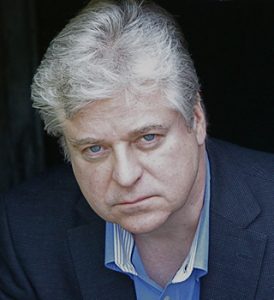

ICONS: Weighing in on the King’s Influence
The Impressive Influence of a King
Welcome to The Big Thrill’s newest column, Icons, where we’ll invite some of today’s brightest genre luminaries to pay tribute to the extraordinary personalities, both real and fictional, who’ve shaped the contours of the thriller world.
Since we chose an October launch for the column, there was little debate about who’d step into the spotlight as our first Icon.
There was certainly a market for horror fiction before newcomer Stephen King collected his $2,500 advance from Doubleday for Carrie in 1973. (News of the manuscript’s sale famously arrived at the King household via telegram because the struggling young family couldn’t afford phone service.) Notwithstanding the pulps of the 1920s and ’30s, the contemporary US horror lit market began to take off in the ’50s with hits like William March’s The Bad Seed and Richard Matheson’s I Am Legend (both published in 1954). Shirley Jackson scored a bestseller, a National Book Award nomination, and a lucrative film deal with her 1959 novel The Haunting of Hill House, while Rosemary’s Baby turned Ira Levin into a pop culture powerhouse eight years later. Actor-turned-novelist Thomas Tryon’s 1971 skin-crawler The Other spent six months on the bestseller list and sold four million copies.
 But in pure market-share terms, it’s hard to escape the notion that these genre titans were just greasing the skids for a young schoolteacher from Portland, Maine.
But in pure market-share terms, it’s hard to escape the notion that these genre titans were just greasing the skids for a young schoolteacher from Portland, Maine.
The circumstances surrounding the writing and publication of King’s debut novel are the stuff of publishing legend. Any acolyte knows that Tabitha King (a formidable author in her own right) rescued the first, crumpled pages of Carrie from her husband’s garbage can and urged him to finish it. The hardcover edition sold well enough to earn out King’s modest advance, but it was the paperback rights sale that changed his life, earning him and Doubleday each a $200,000 payday—the equivalent of more than $1.1 million in today’s market. King has been a mainstay on the bestseller list ever since, with more than 30 of his novels claiming the number one spot. His reign extends far beyond the confines of the printed page—last year, Andy Muschietti’s adaptation of It (well, the first half, at least) became the highest grossing horror film of all time. Last month, during its first weekend at the box office, It: Chapter Two earned more than the rest of the top ten movies combined.
As impressive as King’s own career has been, his influence is even more astonishing. No contemporary writer has singlehandedly shaped our cultural landscape to the extent that King has. It’s simply impossible to imagine the horror genre, or pop culture in general, without him.
My earliest encounter with King is of a decidedly personal nature. My biological dad, John Snellings, was one of the many forgotten novelists who briefly rode the wave of King’s early success during the horror paperback boom of the 1980s. His only published novel, The Carvings, was snatched up by Leisure a couple of years after Pet Sematary capped the New York Times bestseller list. Dad’s book was given an illustrated cover rife with glorious ’80s horror clichés—a creepy kid, an ominous artifact, blood dripping from the claws of a mostly hidden creature—and dumped onto bookstore shelves and drugstore paperback racks all over America.
But if Dad were alive today, he’d probably tell you that the real highlight of his short career as a horror writer was seeing his name share the page with King’s in the table of contents of The 28th Pan Book of Horror Stories, where Dad’s short story “First Come, First Serve” was listed just before King’s “Gray Matter.” Dad’s enthusiasm for King is the reason I found myself huddled in the back bedroom of my grandparents’ house at age 11, wholly absorbed in ’Salem’s Lot, when nature conspired with King to give me one of the biggest frights of my life: at the moment when Danny Glick appears at Mark’s bedroom window, the wind blew a tree branch against my own window, causing it to scratch against the glass. It still takes something out of me to pull back the curtains at night, and I’ve been a King devotee ever since.
To examine King’s incredible, ever-evolving legacy, we’ve gathered four writers whose impressive careers are steeped in his influence: A Noise Downstairs and Elevator Pitch author Linwood Barclay, who counts King among his many loyal readers; Christopher Golden, bestselling author of the horror thrillers Ararat and The Pandora Room and co-author of The Complete Stephen King Universe; lifelong King fan Jennifer Hillier, whose latest novel, Jar of Hearts, earned top honors in the hardcover category at this year’s ITW Thriller Awards; and Paul Tremblay, author of A Head Full of Ghosts and The Cabin at the End of the World, and one of King’s heirs apparent.
It’s worth noting that these interviews were conducted separately, and no panelist was aware of other panelists’ responses. Also, a spoiler alert for anyone who might be new to King’s work: these interviews contain references to plot points in Pet Sematary, ’Salem’s Lot, The Stand, and The Talisman.
What was your first experience with King’s work, and what was your response to it?
Linwood Barclay: It was the movie Carrie, which my girlfriend (soon-to-be wife) and I went to see at the theater in 1976. Those last ten seconds were the scariest thing I had ever seen. I thought, I gotta read this guy.
Christopher Golden: I honestly don’t remember which book I read first, probably because I was so young when I started reading King and I devoured his books so quickly. Yet there are indelible memories for me. I remember picking up the creepy original black cover paperback of ’Salem’s Lot in the Lauriat’s Bookstore in my local mall in Framingham, Massachusetts. I remember—later—seeing the bouncer at a local restaurant called Liam’s Irish Tavern sitting on his stool and reading the brand new, just-released hardcover of The Dead Zone. I remember Sister Maureen, the nun who taught my eighth grade class, gazing in disapproval as I used my free time to read the new hardcover of Firestarter. But above them all, and possibly my first Stephen King novel, I remember picking up a copy of the classic paperback edition of The Stand in Logan Airport in Boston on a family trip to Florida. It’s still my favorite novel of all time, and I believe one of the great American novels. I’ve often said that Stephen King’s authorial voice is the narrative voice of my youth, and that remains true.
Jennifer Hillier: The first Stephen King book I ever read was also the first adult novel I’d ever read, and it was Pet Sematary. I picked it up only because the paperback was on my mother’s nightstand and the cover had a cat on it. I was 11 at the time, and still reading Sweet Valley High, but my mom said, “It’s a scary book, but go ahead and give it a try.” I had no idea that being scared could be so much fun.
Paul Tremblay: I didn’t become a reader for pleasure until my early 20s, later in life than most, I think. I’m almost ashamed to admit my first experience with Stephen’s stories were the ’70s and ’80s film and TV adaptations of his early works. But let’s skip to when I first tried to read one of his books. That’s a mostly fun story.
Six days after graduating high school I underwent spinal fusion surgery to correct my scoliosis (that’s not the fun part). I spent the rest of the summer cooped up in the house while convalescing. So there I was, rocking chair bound, and the beat-up paperback of It, the one with the monster hand coming out of the gutter, had been peeking out at me from the bookshelf. My parents were at work, my siblings were out doing fun summer things, and I was alone in the house. I read It’s first chapter. Poor Georgie. And poor me! I was scared out of my mind. I literally threw the book across the room because there was no way I was going to spend the summer alone in the house and scared out of my mind.
Five years later, shortly after reading and falling in love with The Stand, I mustered the courage to read It.
Is there a particular moment from one of King’s novels or stories that has haunted you since you first encountered it?
LB: When little Gage returns from the Pet Sematary after his father has buried him there. I can’t say for sure whether this is King’s greatest work (I think that might be The Green Mile or 11/22/63) but it is without question his most terrifying.
CG: I have to pick just one? Some are so legendary they verge upon cliché at this point. To choose Danny Glick showing up at Mark Petrie’s window in ’Salem’s Lot, or the Lincoln Tunnel scene in The Stand, would feel like cheating, even though they’re both chilling as hell and linger in my mind to this day. Instead, I’ll pick the end of one of my favorite King stories, a brief sequel to ’Salem’s Lot called “One for the Road.” King gets a lot of crap for his endings, but this one is absolutely note-perfect and I find it chilling no matter how many times I’ve read the story. “There’s a little girl somewhere out there,” the story concludes. “And I think she’s still waiting for her goodnight kiss.” Go read the story. I’m sitting here typing this and I’ve got actual chills up my spine just thinking about it.
JH: The first time I ever cried while reading a book was The Talisman. The scene where Wolf dies was the most painful thing I’d ever read, and I didn’t know you could feel such intense grief just from reading something. I remember crying quietly into my pillow because it was after midnight, and I didn’t want my parents to know I was still awake. The entire scene is still so vivid in my head, all these decades later.
PT: Larry Underwood’s trek through the pitch-dark Lincoln Tunnel [in The Stand]. That scene remains one of the most intense and terrifying scenes I’ve ever read. That scene is tactile: you feel yourself there in the tunnel; you breathe its stale, dead air; you grope blindly in its dark. I think about that scene every time I drive through a tunnel. Thanks a lot, Stephen.
As a writer, what’s the greatest lesson you’ve learned from reading King?
LB: Put your ass in the chair and get to work.
CG: This one’s simple. No matter what effect you’re trying to achieve, it only works if the reader cares what happens to your characters.
JH: He’s taught me how to write strong characters. Whether it’s the protagonist, the villain, or a minor character, every single person King creates is fully realized, layered, and significant in their unique way. I’ve also learned that if you can get the reader to believe in your characters, you can get the reader to believe almost anything.
PT: I learned you didn’t need to elevate atmosphere over character for a horror story; or that atmosphere (a nebulous word if there ever was one) wasn’t the end-all-be-all of horror. King ably demonstrated and continues to demonstrate one can take care and time building empathetic characters and horror often arises from everyday circumstances.
What would contemporary literature in general, and your body of work in particular, look like if King had never been published?
LB: That sounds like a King story: going back in time to make sure Stephen King is never born. Instead of Pennywise, we’d have had to make do with the clowns in public office.
CG: Contemporary literature would be a lot less interesting, a lot less colorful, and a lot less populated. There are hundreds of writers out there who were inspired to pursue the life of a storyteller because they read Stephen King, and I’m certainly one of them. Without King, I doubt I’d be doing this for a living. I’ve been writing full-time for 27 years and I shudder to think what I’d have been doing instead.
JH: So many of us writers grew up reading Stephen King’s work. He made it okay to write commercial and genre fiction, and showed us that there’s no shame in not being “literary.” His work gave me permission to write the kinds of stories I wanted to tell, the kind that I enjoyed reading, regardless of how these books might be classified on a bookstore shelf.
PT: It’s impossible to envision. His work changed the publishing landscape in the ’80s and beyond, never mind his overall impact on popular culture in general. It would be akin to asking what would’ve happened to literature if Charles Dickens had never been published.
As far as you’re concerned, what’s King’s greatest contribution to the horror genre?
LB: King has contributed more touchstones to our popular culture than any other writer in history—the murderous car Christine, the killer clown Pennywise, the possessed dog Cujo, the aforementioned pet cemetery, that creepy hotel in the mountains. The list goes on. But his contribution extends far beyond the horror genre. King is one of the most significant American authors, up there with Hemingway or Roth. They’ll be reading him 200 years from now.
CG: Truly? Humanity. His stories are human stories, full of wonder and terror but also with a moral compass at their core. Horror is, fundamentally, the story of the battle between light and darkness in the human heart. King is constantly reminding us of that.
JH: I’ve just spent 10 minutes staring into space, pondering this, and I don’t think I can choose. Carrie, The Stand, Misery, The Shining, Cujo, It… every one of these stories has stayed with me, years after reading (and re-reading) them. I would say that King’s greatest contribution to writing as a whole continues to be shaping the generations of writers who’ve come after him. He’s helped us believe that there’s an audience for all of our stories, and that what’s most important is not so much writing what we know, but writing what we love.
PT: Stephen didn’t write gothic stories about aristocrats and he didn’t write stories about upper class urbanites/professionals and he didn’t write stories about career academics. He wrote about working and middle class people and he often wrote (and continues to write) about their lives and economic challenges and does so in a way that’s always authentic and doesn’t fetishize their experience by painting their lives as unremittingly miserable. I saw my factory-worker dad and bank-teller mom in Stephen’s stories, and that meant something to me as a reader (it meant everything, really). For so many of us, Stephen wrote about the people we knew and the towns we lived in, which make the stories all the more frightening, thrilling, and fun.
Photo credit (homepage): Shane Leonard
- Between the Lines: Rita Mae Brown - March 31, 2023
- Between the Lines: Stephen Graham Jones - January 31, 2023
- Between the Lines: Grady Hendrix - December 30, 2022









